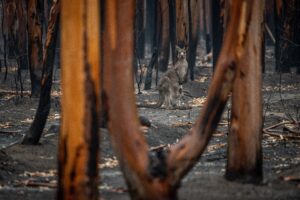The meteorite was found at the remote Kybo Station on the Nullarbor Plain last year.
It weighs just 70g – about the same as a large egg – and looks remarkably like a piece of kangaroo poo.
The tiny space rock was found in the vast WA outback using drone footage of a 5 square kilometre ‘fall zone’. Artificial intelligence then scanned the footage for meteorites – and voilà!
It’s the first time this method has been successful anywhere in the world.
Catch a falling star
Curtin University planetary scientist Dr Eleanor Sansom is no stranger to meteorite hunting.
She’s the lead researcher and program manager of the Global Fireball Observatory. The international project takes pictures of meteors – or shooting stars – as they burn up in the Earth’s atmosphere.
“We’re actually looking for the larger ones,” says Eleanor. “We call them fireballs because they’re a lot brighter and they’re a lot bigger.”
“So maybe something the size of a football, or even up to the size of a washing machine, will come through the atmosphere and make a really, really bright light.”
The scientists use multiple cameras to triangulate an incoming meteorite’s position and predict where it might land.

If the meteorite is big enough and lands in clear terrain, they go out and search for it on the ground.
Eleanor says the team tends to look for objects about 50g and up.
“The bigger the better really, it’s much easier to search for,” she says.
The team can also track backwards to determine where in the Solar System the rock has come from.
A step forward
The Global Fireball Observatory recovers about one meteorite a year.
“To put this into perspective … there’s currently still less than 45 rocks out there that we have orbits for,” says Eleanor.
One of the challenges of hunting meteorites on foot is that humans are easily distracted.
“When you go and search, you actually get quite tired very quickly looking for a [small] rock and you start daydreaming,” she says. “It’s very easy to miss something that small.”
That’s where the drone technology comes in.
“It worked amazingly well and found this 70g rock in the middle of the desert,” says Eleanor.
The algorithm picked up not only what the researchers trained it to look for – black rocks – but anything out of the ordinary as well.
“It found kangaroos, it found snakes, it found all of our field equipment,” Eleanor says.
“So we’re really excited to play with this in the future for search and rescue and other applications.”
Space explorers
Eleanor also worked with the Japanese space agency JAXA when the Hayabusa2 mission landed in South Australia in late 2020.
The spacecraft travelled for 6 years to the kilometre-wide asteroid Ryugu, then returned to Earth carrying two samples from the asteroid.
“It all ties in to trying to understand what happens when these space rocks come through the atmosphere,” says Eleanor.
“Obviously, Hayabusa2 was a man-made spacecraft but it still had to come in from out in the Solar System. It’s still going [at] those hypersonic speeds.”

Eleanor says the team used Hayabusa2 to test how good they were at tracking the position of an object coming in through the Earth’s atmosphere. They also listened for shockwaves coming off the capsule.
The team hopes to link the seismic and sound data from Hayabusa2 to their own fireballs and perhaps even NASA’s Mars InSight mission.
Eleanor loves that there’s still so much to discover.
“It’s just that sense of … being an explorer,” she says.
“Back in the day, [people were] exploring what continents were out there, and now we’re trying to move on and explore what’s out in space.
“And just realising how little we actually know about our own Solar System.”










